Thin Section Bearings
Table of Contents
Definition
Thin section bearings, also known as slim bearings or thin-walled bearings, are a type of ball bearing designed with exceptionally thin rings and a limited number of rolling elements.
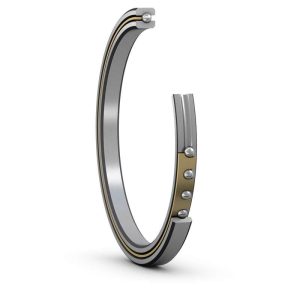
FHD Bearings is an ISO 9001:2015 certified manufacturing enterprise that stocks a full range of thin section bearings,deep groove ball bearings, angular contact ball bearings, thrust ball bearings, Self-aligning ball bearings and ceramic ball bearings. With over 1,200 different bearing sizes and over 250K bearings in stock.
Materials
– Chrome steel is a widely used material for thin section bearings due to its excellent strength and durability. It provides good resistance to wear and corrosion. Chrome steel bearings are suitable for many general applications.
– Stainless steel is chosen for its exceptional corrosion resistance. Bearings made from stainless steel are ideal for applications where exposure to moisture, chemicals, or corrosive environments is a concern.
– Plastic or polymer bearings are used in applications where lightweight and corrosion resistance are essential. They can be made from various types of plastics, including nylon, PEEK, or UHMWPE. Plastic bearings are commonly found in food processing, pharmaceuticals, and some conveyor systems.
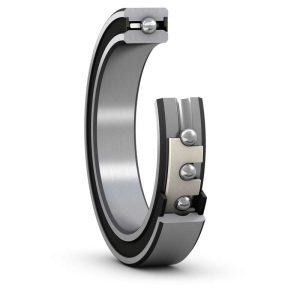
Hybrid
– Hybrid bearings combine the characteristics of steel and ceramic. These bearings feature ceramic balls within a steel race, offering the advantages of both materials. They are known for their reduced weight and improved performance, making them suitable for various applications, including high-speed and precision machinery.
Features
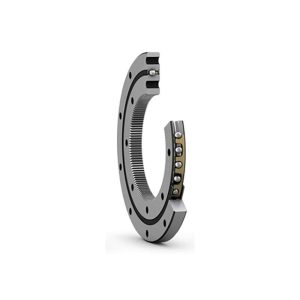
- Thin Rings: Thin section bearings have thin, closely spaced inner and outer rings, which reduce their overall cross-sectional profile.
- Limited Rolling Elements: These bearings typically have fewer rolling elements, such as balls, than standard bearings. The reduced number of elements results in a narrower bearing, making them “thin.”
- High Precision: Thin section bearings are often designed for high-precision applications, where tight tolerances and smooth operation are critical.
- Space-Saving: Their thin design allows for space-saving solutions in applications with limited axial and radial space, where a standard-sized bearing may not fit.
- Lightweight: Due to their reduced size and material usage, thin section bearings are generally lighter than their standard counterparts.
- Reduced Friction: These bearings can offer lower friction due to their design, which can lead to energy savings and improved efficiency in various applications.
- Customizable: Thin section bearings can be customized to suit specific applications, including variations in size, materials, and sealing options.
Advantages
- Space-Saving Design: Thin section bearings have a compact and slim profile, making them ideal for applications where space is limited.
- Low Friction: These bearings often exhibit low friction characteristics, reducing energy consumption and heat generation, making them suitable for high-speed and efficient applications.
- Customization: Manufacturers offer a range of customization options for thin section bearings, allowing them to be tailored to specific application requirements, including variations in size, materials, and sealing options.
- Quiet Operation: Thin section bearings are known for their quiet and smooth operation, which is important in applications where noise reduction is essential.
- High Load Capacity: Thin section bearings are designed to handle significant loads despite their slim profile, making them versatile in various load-bearing applications.
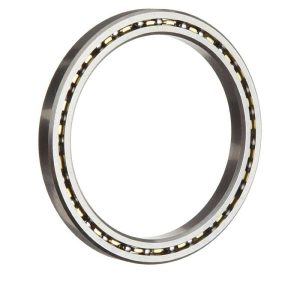
Taxonomy
Reali-Slim thin section bearings

Reali-Slim thin section angular contact ball bearing
These angular contact ball bearings can accommodate radial and axial loads acting simultaneously, where the axial load acts in only one direction.

Reali-Slim thin section four-point contact ball bearing with seals or shields
Four-point contact ball bearings with seals or shields can accommodate radial, axial and moment loads simultaneously.

Reali-Slim thin section radial contact ball bearing with seals or shields
Radial contact ball bearings with seals or shields are designed to accommodate radial loads and some axial loads in either direction.
Ultra-Slim thin section bearings

Ultra-Slim thin section angular contact ball bearing
These angular contact ball bearings can accommodate radial and axial loads acting simultaneously, where the axial load acts in one direction only.

Ultra-Slim thin section radial contact ball bearing
Radial contact ball bearings with seals or shields are designed to accommodate radial loads and some axial loads in either direction.

Ultra-Slim thin section four-point contact ball bearing
Four-point contact ball bearings can accommodate radial, axial and moment loads simultaneously.
Customized thin section bearings

Reali-Slim TT turntable thin section bearings
Reali-Slim turntable bearings are small-scale thin section bearings designed for demanding applications. They are based on a single four-point contact ball bearing design.

BB series metric thin section ball bearings
BB series metric thin section ball bearings are based on a four-point contact ball bearing. They are designed to match the bores and widths of common cross-roller bearings.

KT series thin section tapered roller bearings
KT series thin section tapered roller bearings are designed primarily for radial load applications. Since these bearings have a contact angle of approximately 12° under axial load, they can accommodate a reasonable amount of axial load.
Applications
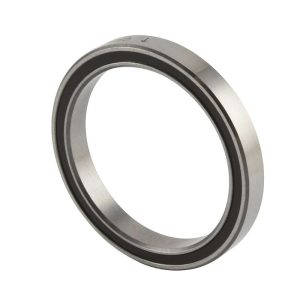
- Aerospace and Aviation:Their compact design and lightweight construction make them ideal for reducing the overall weight of aircraft components.
- Robotics:Their compact size helps reduce the bulk of the robotic structure.
- Medical and Surgical Equipment: Thin section bearings are utilized in medical devices, such as X-ray machines, CT scanners, and surgical equipment
- Semiconductor Manufacturing:Thin section bearings are used to provide accurate and precise movement in critical processes like wafer handling, lithography, and inspection.
- Radar and Antenna Systems: Thin section bearings are employed in radar and antenna systems, where they enable precise rotation and positioning of antennas and radar arrays.
- Telescope Mounts: In astronomy, thin section bearings are used in telescope mounts to facilitate precise tracking and movement of the telescope’s optics.
Key Manufacturing Process of Thin section bearings
Raw Material Selection
The first step is selecting high-quality steel or other materials with the necessary properties, such as hardness and corrosion resistance, to ensure the bearing’s performance and durability.
Tube Cutting
A steel tube is cut into individual rings or races, which will serve as the outer and inner ring of the bearing. The diameter and thickness of these rings are closely controlled during cutting.
Raceway Machining
The inner and outer raceways are machined with precision to create smooth and accurate tracks for the rolling elements (balls or rollers). This step is crucial for ensuring proper load distribution and minimizing friction.
Ball or Roller Production
The rolling elements, such as balls or rollers, are manufactured separately to precise dimensions and tolerances. These elements are typically made from high-quality steel and may undergo heat treatment processes to enhance their hardness and durability.
Assembly
The individual components, including the inner and outer raceways and the rolling elements, are assembled in a controlled environment to create the bearing assembly. Precision assembly techniques are essential to ensure proper alignment and minimal internal clearance.
Lubrication
Bearings are lubricated with grease or oil to reduce friction and dissipate heat during operation. The type and amount of lubrication are carefully chosen to meet specific performance requirements.


FAQ - Frequently Asked Questions
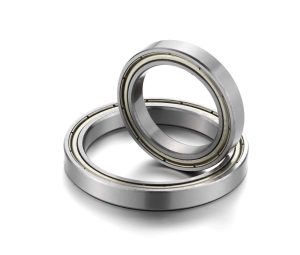
Thin section bearings are a type of ball or roller bearing with a very thin cross-section relative to their bore diameter. They differ from standard bearings by their reduced size and weight, making them ideal for applications with space and weight constraints.
Thin section bearings are commonly used in aerospace, robotics, medical equipment, semiconductor manufacturing, radar systems, and various precision machinery applications.
Thin section bearings offer reduced weight, space savings, and low friction, which can result in improved efficiency and performance in machinery and equipment.
Thin section bearings generally have lower load capacity compared to standard bearings due to their reduced size, but they are designed for applications with lighter loads and where space is limited.
Thin section bearings are typically made from high-quality steel, stainless steel, or ceramic materials, with variations to suit specific application requirements.
Thin section bearings are lubricated with grease or oil to reduce friction and dissipate heat. The type and amount of lubrication depend on the specific application and operating conditions.
Yes, some thin section bearings are designed to withstand high-temperature environments, but the specific temperature limits depend on the material and design of the bearing.
The installation process typically involves proper alignment, securing, and often torque specifications to ensure optimal performance and longevity.
Factors to consider include load requirements, operating environment, size constraints, and precision requirements.
Manufacturers provide load capacity data for thin section bearings, which can be used to calculate the loads based on the specific application.
Regular inspection, proper lubrication, and protection from contamination are essential for maintaining and extending the lifespan of thin section bearings.
Types include open, shielded, and sealed thin section bearings, as well as angular contact and four-point contact designs.
While some designs allow limited misalignment, it’s generally best to minimize misalignment to ensure optimal performance and bearing longevity.
Depending on the application and bearing design, special tools and procedures may be needed for precise mounting.
The choice of seal or shield depends on the level of protection needed. Seals provide better protection but may create more friction.
Careful selection of the bearing type and proper installation practices can help prevent brinelling or false brinelling.
Common failure modes include fatigue, wear, and contamination. Prevention measures include proper maintenance and lubrication.
Yes, manufacturers often offer customization options for thin section bearings to meet specific application requirements.
Thin section bearings are slim and lightweight, making them ideal for applications where space and weight are critical factors.
Real-world applications include aerospace components, robotic arms, medical devices, and more, where thin section bearings improve efficiency and performance.
Installation and Maintenance
Installation
- Cleanliness: Ensure all components, including the bearing, shaft, and housing, are meticulously clean and free from contaminants to prevent premature wear or damage.
- Alignment: Achieve precise alignment of the bearing with the shaft and housing to prevent misalignment issues, which can lead to increased friction and reduced bearing life.
- Lubrication: Apply the recommended lubricant to the bearing’s raceways and rolling elements, following the manufacturer’s specifications for the type and quantity of lubrication.
- Torque: If specified, use a torque wrench to tighten fasteners or set screws to the manufacturer’s recommended torque values, ensuring secure attachment without over-tightening.
- Secure Fastening: Utilize the appropriate method for fastening the bearing in place, such as retaining rings, set screws, or other suitable fasteners, following the manufacturer’s instructions.
- Rotation Check: After installation, verify that the bearing rotates smoothly and without binding or excessive friction. Investigate and address any resistance issues immediately.
- Documentation: Maintain records of the installation process, including torque values used, lubrication details, and any special procedures followed during installation for future reference and maintenance.
Maintenance:
- Regular Inspection: Conduct routine visual inspections of the bearings to check for signs of wear, damage, or contamination. Look for any abnormalities in bearing operation, such as unusual noise, vibration, or increased friction.
- Lubrication: Reapply lubrication as needed. Ceramic bearings generally require less lubrication, but it’s essential to maintain a thin film of lubricant to reduce friction.
- Environmental Control: Ensure that the operating environment remains clean and free of contaminants that can damage the bearing. Implement seals or shields if necessary to protect the bearing from dust, dirt, and moisture.
- Temperature Monitoring: Regularly monitor bearing temperature during operation. Abnormal temperature increases may indicate a problem with lubrication or excessive loads.
- Alignment Checks: Periodically check the alignment of the bearing within the machinery to prevent misalignment issues, which can lead to premature wear and increased friction.
- Load Limits: Be mindful of load capacities and avoid overloading the bearing. Operating within specified load limits is crucial to prevent bearing damage and failure.
- Replacement Timing: Establish a maintenance schedule for bearing replacement based on the manufacturer’s recommendations and the bearing’s operating conditions. Replace the bearing before it reaches the end of its service life to prevent unexpected failures.




